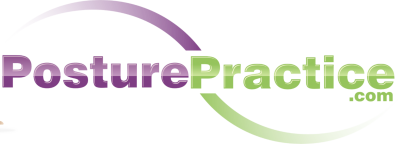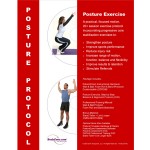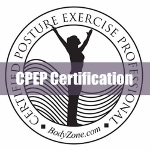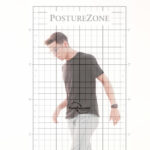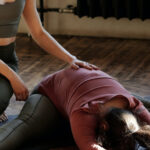Reduction of Pain in the Chronic Pain and Headache Population
Receiving amazing case histories from doctors and therapists using our work always makes my day. Especially as new research supports the threads we’ve woven into the StrongPosture® protocols, it’s truly gratifying to hear about the people being help by CPEPs using our work.
I’d like to share a hospital-based physical therapists’ experience with chronic pain patients, and how she’s helping them to find the long neglected links in their body’s motion system to strengthen their kinetic chain with results like this:
1. “Ron”: A 32 yo electrician supervisor with chronic LBP who works out at the gym 5x/week and has excellent muscular definition. He started PT with perhaps the worst posture I had seen in several years for someone his age and he was completely unaware of this. After learning the StrongPosture Protocol (SPP) exercises, he stated that he felt empowered leaving the first session especially after seeing his before and after Posture Pictures with just completing Wall Tilts. He was shocked “how much better I can walk after doing these exercises with my core more engaged”. After several more sessions, his postural transformation is quite miraculous and he agrees as he has picture evidence.
Laurie Lackman is a Physical Therapist with 34 years of experience who focuses on inpatient rehab of chronic pain patients at Tampa General Hospital. In her own words, here’s what Laurie had to say about her StrongPosture® training:
StrongPosture® Protocols can contribute to Increased Exercise Compliance, Improved Patient Satisfaction and a Reduction of Pain in the Chronic Pain and Headache Population
Having worked with the Chronic Pain population for over 20 years, I have routinely sought out various interventions in an effort to bring relief to my patients. These included Craniosacral therapy, myofascial release, Graston Technique, Microcurrent Point Stimulation, Therapeutic Neuroscience Education strategies for pain just to name a few (in addition to more traditional PT interventions). With each new technique that I implemented, I would see some benefit to my patients but nothing earth shattering. Additionally, the age-old problem of adherence to a Home Exercise Program (especially in the Chronic Pain population) has always frustrated therapists despite seeking out further education on various psychological strategies to attain buy in and compliance (such as motivational interviewing). Acutely understanding that passive interventions alone are not nearly as effective as a combination of manual and active strategies in addressing persistent pain, I was very attracted to the Strong Posture philosophy.
After attending the Strong Posture weekend, it was a breath of fresh air! I loved the research based, systematic approach to dealing with weak posture that inevitably leads to chronic pain conditions. It really synthesized all the education I had received over the years into an easy to implement system that integrates balance, alignment and motion along with awareness and self-reliance into 1 approach that all of my patients can benefit from.
Once I returned to the clinic following the Strong Posture weekend, I immediately started to implement the protocols with both my persistent and acute pain patients. These patients were now “switched” from more traditional PT approaches, to the Strong Posture protocols which uniquely allowed them to compare and contrast both interventions. I felt that sharing many of their reactions would be very insightful and supportive of the Strong Posture approach.“
The reason Laurie got results boils down to the fact that in the human body, everything is connected… but you can only focus on one thing at a time. Mechanically, everything is linked together.
The effects of back pain on whole body balances was the thread in the StrongPosture® tapestry demonstrated by this week’s study from Noguiera et.al., Posturography Comparison and Discriminant Analysis Between Individuals With and Without Chronic Low Back Pain.
Conclusion: For the people in the study, those with “chronic LBP had worse postural control performance than matched controls.”
Therefore, effective rehab must focus on the whole body. Also, complexity mushrooms when you add the effects of Mind on the Body, which in turn then grow exponentially when you factor in the interactions of the Body on the Mind. Standing with your torso erect doesn’t improve posture if you have to bend your knees to do so. Everything is connected, and efforts to change are limited by physics of our body, and the limits of our ability to focus.
Which is why another way to look at StrongPosture® Rehab is reprogramming the minds perception of the whole body, for her results from our “simple” exercises ,systematically applied to strengthen postural control.
2. “Kayla”: A 27 yo Muscular Dystrophy patient coming to PT for chronic LBP- she stated the SPP (strong posture protocol) exercises were “easier to incorporate into my exercise routine”, she really liked the “mental focus “ they required and she could tell that “they focused on my total core strength”.
Simplicity is the truth on the far side of complexity. The StrongPosture® protocols work because we focus on changing one thing at a time, in bio-mechanically logical sequences, in a framework to apply to any body, as a baseline for any rehab (and functionally strengthening posture all the rehab that’s necessary for many cases).
Especially for cases of debilitating, hard to diagnose problems like Complex Regional Pain Syndrome (CRPS) in highly educated people
3. “Deborah”: A 62 yo disabled MD with total body chronic pain including CRPS and she has been through MANY years of various PT interventions. She stated she found herself wanting to only do the SPP exercises and felt “very encouraged with the ball hug into leg lifts because these exercises make me feel in control without hurting” and she later stated “I feel better when I do them” citing all the exercises she had learned in the protocol. She was very surprised how much better she could balance with the Stork Peelback and this was extremely gratifying to her. As a result, she wanted to practice more. Seeing her Posture Picture and video walking progressions was extremely reinforcing to her and beneficial in combating her depression which is a significant barrier to her continued progress.
Systematically individualizing exercise for anyone is the strength of the StrongPosture® rehab protocols. The MUST vs TRY cueing of the BAM progressions let professionals customize StrongPosture® exercise for just about anyone doing rehab, and everyone interested in improving posture.
Nogueira, J. F., Carrasco, A. C., Pelegrinelli, A. R. M., Guenka, L. C., Silva, M. F., Bela, L. F. D. et al. (2020). Posturography Comparison and Discriminant Analysis Between Individuals With and Without Chronic Low Back Pain. Journal of Manipulative and Physiological Therapeutics.
StrongPosture Rehab Protocol Training Manual, S. Weiniger, BodyZone Press, (2000, 2016).
For more about StrongPosture® and to incorporate it in your practice get the Posture Rehab Exercise Program and take the latest training via the online rehab course, Posture and Balance Assessment, Rehabilitation, and Motor Control Exercise.
